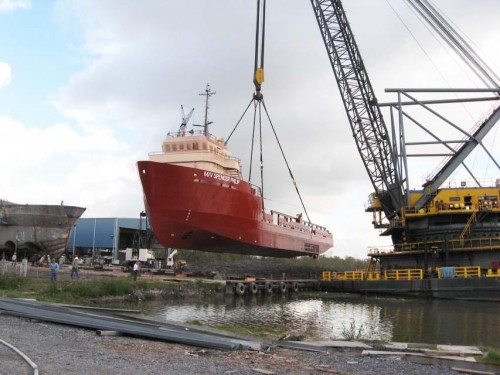Dec. 29
December 28, 2009Raphael ‘Ralph’ Chauvin Sr.
December 30, 2009Another decade is about to end, but the fight for local port infrastructure funding is far from over.
With funding sources exhausted, statewide ports are struggling to keep pace. However, the question still beckons; Who do local ports turn to for more money?
Joe Accardo, executive director of the state’s ports, told members of the South Central Industrial Association last week, Louisiana needs about $850 million in port infrastructure and channel improvements in order to be competitive with the rest of the nation.
The large sum of money would come from a 5-year capital improvement plan that has numerous facets intended to develop a sufficient, sustainable source of funding for local ports.
He also noted $450 million had been spent over the last five years by local ports, 70 percent of which came from their own resources.
According to Tim Ryan, an economist from the University of New Orleans, 31 ports throughout Louisiana currently produce $5.66 billion in job revenue, $467 million in tax revenue and create nearly 270,000 jobs. The maritime industry is also responsible for producing 23 percent of Louisiana’s gross state product.
Local port directors are looking for those numbers to grow. But with limited funding, those hopes are fading.
Between $20 and $25 million in state funding is allocated to ports yearly through the port priority program, which provides local ports with funding to improve infrastructure, Accardo explained.
In order to acquire a piece of the pie, ports must go through a series of steps including numerous applications and approvals. Even then, ports are required to provide money up-front to complete projects and are later reimbursed.
While millions in funding may be approved, Accardo said the state is only required to grant up to $5 million per year to each project, with a $15 million cap on all approved projects.
In 2009, nine projects were approved, totaling $78 million. An additional $55 million would be needed to complete those projects, all via port revenue. “State money is often authorized but not actually available,” said Accardo.
More importantly, projects are awarded funding based on “worth” and the amount of impact they will have on the community. Fourchon Port Director Chett Chiasson said that funding is given to “…who is going to give the most bang for the state’s buck.
“Limited funding often requires ports to do projects over a 3- to 5-year period, slowing growth potential and reducing revenue,” he added.
Accardo said that increases in gas and vehicle sales tax were a possibility to bolster the amount of money available to local ports. But officials fear raising the gas tax could become political warfare.
“Right now, we’re trying to find a [new] source of funding that is politically acceptable,” explained Accardo.
States like Florida and Virginia have already taken steps to put local maritime industries on the transportation grid, allowing ports to take advantage of revenue brought in by the transportation industry.
“Louisiana ports are quickly becoming inefficient and outdated,” warned Accardo. While area channels and waterways are shrinking, vessels are becoming larger.
Problems hit home
Terrebonne Port Director David Rabalais said that nearly 500 acres of land in Terrebonne needs to be developed before it could be used to accommodate maritime activities. Out of that 500 acres, over 250 need to be mitigated.
“First we would have to come up with a mitigation plan, which could cost several million,” claimed Rabalais.
He would also like to upgrade existing roadways located near the port. “Right now I have to spend about $3,000 a month to keep them in fair condition.” In order to upgrade the gravel surfaces to blacktop, Rabalais needs more money.
“There just isn’t enough money,” he said. “People aren’t aware of how valuable a port is to the community when it comes to jobs and taxes.”
For every dollar invested in the port priority fund, $6 is returned to Louisiana in taxes, jobs and benefits, touted Accardo. More jobs would mean more taxes – resulting in more money for local governments hoping to revamp roadways, schools and other public works projects.
With an extra $2 million, Rabalais claimed, “I could really, really create a lot of jobs and put Terrebonne Parish on the map.”
Adding to a laundry list of needs is a building. Rabalais currently runs the port from an office located in the Government Towers in Houma. “I’m stuck over here 10 miles from the port, so it gets difficult to operate.”
Industry officials are also hoping to create a state office of ports and maritime industry, something that would prioritize the needs of ports statewide.
South Louisiana’s geographical location is of utmost importance, said Accardo, therefore it has a few advantages:
Access to the Mississippi River, the largest inland waterway.
Strategic location for oil, gas and petrochemical industries.
Large maritime workforce and professional base.
Ownership and investment in multiple port types.
But without money, those advantages could quickly become losses. “[Funding] is really important because we’re in a good location and have the ability to grow as fast as the funds come in. If we have money, we can grow as fast as we can [build]. But without funding business is going to slow,” Chiasson said.
Even more damaging is an increased deficit. Rabalais said that nearly $80 million in projects for 2009 are backlogged. The only way to get them off the ground: money.
“That $20 million is just not enough to fund 30-something odd ports,” he added.
Projects for 2010 through 2011 total about $65 million, said Accardo. If approved, they would fall behind the ’09 projects that have yet to be completed.
Like others, Rabalais is calling for more money to be put into the port priority program. But how that will happen is still unknown.
If additional funding is not secured, ports could face even greater hardships down the road. “We [would] be handicapped and would lose opportunities to other states that normally we would of kept here,” said Rabalais.
“What hampers the [ports’] ability to grow is the fact they have to phase out construction, plus the money [granted by the state] is never assured,” acknowledged Accardo.
A boat built by ThomaSea Boatbuilders is launched at the Terrebonne Port. Funding for local ports is scarce, making new projects nearly impossible. * Photo courtesy of TERREBONNE PORT













